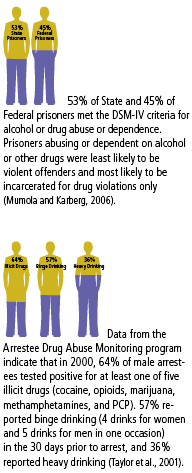

Criminal Justice
The Bureau of Justice Statistics measured alcohol and other drug problems for the first time on the 2004 Survey of Inmates in State and Federal Correctional Facilities using DSM-IV criteria for drug abuse or dependence. Based on the results of the survey, prisoners were more likely than adults in the general population to meet the criteria for drug dependence or abuse (Mumola and Karberg, 2006).
Drug users commit a disproportionate amount of all types of crime, not just drug possession offenses (Marlowe, 2002). 80% of state and federal inmates have been incarcerated for alcohol or drug-related offenses, intoxicated at the time of their offense, committed the offense to support their addiction, or had a history of alcohol abuse or dependence and/or illegal drug use (CASA, 1998).
FAMILY COURT
Alcohol and other drug problems contribute to a wide range of problems. Many parents are likely to appear in family court in proceedings involving divorce, domestic violence, child abuse and neglect (McMahon and Giannini, 2003).
In family courts, judges are faced with difficult decisions about whether a parent or guardian with substance problems should remain in the household, have custody or unsupervised visitation rights, or have their parental rights terminated. Such measures can be destabilizing and create burdens on society and should be reserved for the most extreme cases. Many children unsafe in their own home are placed in foster care to allow time for treatment to stabilize parents and prevent further maltreatment when and if children return home. However, the treatment timeline for adults with substance use disorders may be inconsistent with the timeline imposed by federal statutes for resolving the status of children in foster care. This means that parents who are in treatment but still struggling with relapse and recovery may find their parental rights terminated because of the pressures imposed by federal law (CASA, 1999; BOLT, 2007).
JUVENILE JUSTICE
More than two million youth are charged with delinquency offenses and enter into the juvenile justice system each year. 62.5% report alcohol and other drug problems (National Institute of Justice, 2003), while 75% also report mental health problems (Drug Strategies, 2005). Many of these individuals also have other problems that may influence their delinquent behavior and their use of alcohol and other drugs. Availability of treatment is a serious problem in the juvenile justice system with fewer than 3% of adolescents in the juvenile justice system that need treatment receive it (CASA, 2004).

|










